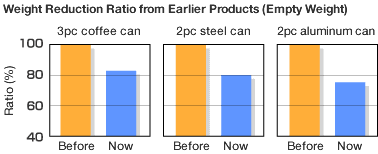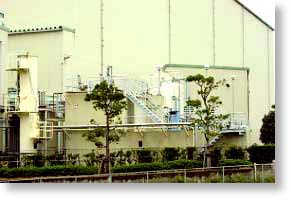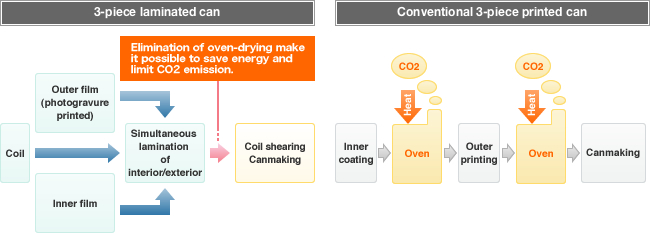
Home > Press Room Top > Environment > 3R Strategy > 3R Strategy: Reduce

As part of an effort to reduce the amount of raw materials and the CO2 emissions from the manufacturing process, Daiwa Can continuously works to develop lighter-weight and thinner body can products.
During the drawing and ironing (DI) process of can manufacturing, water is used to rinse out the lubricant. We have tried to reduce the amount of water required for this process and realized a substantial reduction making full use of our technological prowess that produced the world’s first tinplate DI can.

In addition, the New Bottle Can, one of our recent eco-friendly products, even requires no washing water during the manufacturing process, producing no wastewater and less industrial waste.
Our factory wastewater goes through a treatment system that combines physical, chemical, and biological treatments as well as filtration and activated carbon adsorption treatment and is safely returned to rivers. The treatment system was designed on the basis of basic research conducted by our Central Laboratories and is able to remove even very small waste particles.
In consideration of air pollution, our manufacturing plants use LPG and LNG, which produce no sulfur oxides (SOx), for fuel. Furthermore, our New Bottle Can and 3-piece laminated can, whose inner and outer surfaces are coated with PET films, require no drying oven process during the production. This contributes to both the reduction of CO2 emissions and energy saving.

During the printing process of cans, volatile organic compounds (VOC) evaporate within an oven and have to be emitted. In 1970s, Daiwa Can conducted an extensive research to tackle with this issue both from standpoint of painting materials and removal equipments. The result was our originally developed incinerator, which removed both VOC and accompanying odor. The thermal energy of the incinerator is recovered and reused, contributing to some energy savings.
If products are packed using our aseptic filling system, it eliminates the need for refrigeration during transportation and storage, resulting in the CO2 emission reduction during those stages.